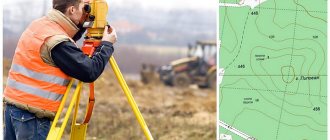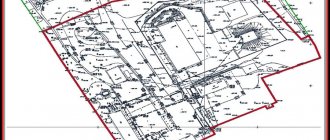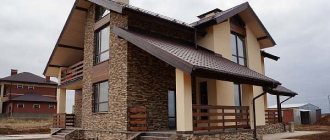Why register a house in SNT?
A house built without appropriate registration is recognized by law as unauthorized construction. The building acquires the status of a real estate object, and you - its owner, after geodetic and cadastral registration.
Registered real estate gives the owner:
- the owner’s rights to dispose of property in full, and this is sale, donation, inheritance, pledge, lease;
- marking the boundaries of a land plot in kind, reducing the risk of conflicts due to demarcation with neighbors;
- simplifying the connection of gas, electricity, heat and water supply networks.
On what lands is construction allowed?
All land resources within the country have different purposes and special legislative regulation. Land legislation provides for their division into several categories (Article 7 of the Land Code of the Russian Federation).
The articles of the Land Code provide a complete list and description of them:
- agricultural lands;
- lands of populated areas;
- lands of defense, industry and other special significance;
- lands of specially protected objects and territories;
- forest fund lands;
- water fund lands;
- reserve lands.
Each of these categories has a special status, rules and restrictions for use. You cannot change the purpose of land or types of permissible use at will. According to current laws, it is determined that development is allowed on the first two types of land. At the same time, the status of buildings permitted for construction on them varies.
Registration is the right of the owner
The owner of the land or his authorized representative can register a house in SNT. The procedure is as follows. The land of the partnership belongs to SNT, but having received an allotment there, the owner has the right to build a house on it, outbuildings, grow crops and, most importantly, register ownership of this plot. The registration procedure in the cadastre makes the land plot an independent object, and the owner the owner.
Federal Law No. 93 gives the right to register a building when registering an inheritance: when the heir has documentation for the plot in his hands, but the ownership rights have not yet been formalized.
The law covers land plots acquired before the entry into force of the Land Code of the Russian Federation (2001).
What is a country house according to the new law?
All DNT are SNT, and country houses are garden houses, according to Federal Law No. 217-FZ of July 29, 2017. The concept of country houses and permitted use as summer houses has been abolished.
Country property is equivalent to garden property. On the former DNT, as well as on the SNT, it is possible to build capital construction projects and register them according to the technical plan; these will be full-fledged residential buildings with the right to register residence.
Another current form of the ONT partnership is plots for vegetable gardening. But on these lands it is not allowed to build houses, even for seasonal residence, only buildings for storing equipment.
Link to document:
Read: Dacha amnesty extended until 2026: how to register a house and land
Nuances of registering land and buildings in SNT according to Federal Law No. 93
Federal Law No. 93 treats buildings as illegal if they are not properly registered. In litigation, for example with neighbors, it is difficult to defend your rights to illegal construction. A decision on demolition may be made. It’s easier to register a building than to pay for lawyers, court costs and demolition.
Federal Law No. 93 normalizes the registration of houses in SNT and DNT, built before the Land Code, the main regulator of land law in the Russian Federation, came into force.
Other registration details:
- Capital buildings are registered as property; the provisions of the law do not apply to temporary and utility buildings;
- Buildings up to 3 floors high are registered, including the basement and basement;
- There are no building area requirements, but large structures may raise questions and difficulties.
A house cannot be registered as a property if it:
- transferred for use under a lease agreement;
- transferred for free use;
- is of cultural value;
- the territory of the land plot is located in a national park or reserve.
In any case, before starting the registration procedure, it is better to get qualified advice, eliminating unnecessary expenses and saving your own time.
The “dacha amnesty” was introduced in 2006 and then extended. The latest extension until 2021 has complicated the procedure, and it is difficult to say whether it will be extended in the future or whether it will become even more complicated. There is no need to risk delaying the registration of capital buildings in SNT, especially considering the possibility of free registration by municipal services until the 20th year.
What kind of houses can be built
Many people, having purchased a dacha, begin construction on it. At the same time, they do not think about what kind of buildings can be erected on such land plots. And in vain! After all, unauthorized construction of buildings, even on land that is private property, can cause problems with the law.
It is important! To build a residential building on country land, you must obtain permission from the construction services, providing a design. Ignoring this rule can lead to the imposition of various sanctions on the owner of the house, including the demolition of the structure.
A summer cottage plot is primarily intended for growing cultivated plants. Despite this, it is permitted to erect residential buildings on the territory of such an allotment. However, it is important to consider that according to the law, all buildings in a dacha should not occupy more than 30% of the total area of the territory. The rest of the land should be used for its intended purpose, that is, planted with plants.
There are a number of buildings that can be erected at the dacha. At the same time, when choosing a building of one type or another, it is necessary to study all the requirements for it.
What kind of houses can be built in the country:
- Residential building up to three floors high;
- Garage;
- Bath;
- Various utility buildings.
At the same time, when constructing a residential building, it is necessary to comply with all SNiP requirements for residential buildings. Otherwise, you will not be able to register with it.
Algorithm of actions
A plot registered in the cadastre and a capital house that complies with the requirements of the law can be registered as the property: first, registration of the land will be required, then the capital buildings on it. If the boundaries of a land plot are defined in the cadastre, registration of the house is carried out sequentially in several steps.
Step 1. Technical plan of the house
Drawing up a technical plan is necessary to obtain a cadastral passport for the building. Here you will need the services of a certified cadastral engineer or a company that has a permit from Rosreestr for this type of activity. The technical plan shows the dimensions of the building, reference to coordinates, layout, entrances to the building, location of openings. In multi-storey buildings, floor plans of construction are shown. It also includes a text part that describes the parameters of the property, including the cadastral value.
The price of the work ranges from 10,000 rubles, depending on the area of the subject, region, and remoteness.
Step 2. Package of documents
The owner's package of documents for registration of the building includes:
- Application in the prescribed form();
- Passport of the owner-citizen of the Russian Federation;
- Extract from the Unified State Register of Real Estate;
- Technical documentation for construction;
- Invoice for payment of state duty.
To register a house in SNT as residential (permanent residence), you must obtain a construction permit, the issuance of which depends on the category of land and the permitted type of use. A non-residential building does not require these documents.
Step 3. Registration
The prepared documentation and application are submitted through the MFC, in person or by post. In return, when submitting to the MFC, you will receive from the operator a list of accepted documentation, the registration period and the date of issue of the statement completing the registration procedure.
Frequent reasons for refusal of registration
Rosreestr's refusal to register is inevitable if:
- Your case does not fall under Federal Law No. 93. A standard registration procedure will be required.
- Ownership of the plot has not been confirmed. It is required to register the plot in the cadastre, with the procedure for land surveying and registration.
- Missing some documents. The operator must state the reason for the refusal.
- Incorrect information. Having eliminated the errors, the procedure can be continued.
Site planning rules
After checking all the documents, you can start planning. The general requirements in accordance with which site planning should be carried out are enshrined in SNiP 30-02-97.
Their difference from SP 11-106-97 (which are mostly advisory in nature, especially if their individual provisions are not specified in the SNT charter) is that the requirements of SNiP are mandatory for all owners of land plots with an area of more than 6 acres.
The first thing you should pay attention to in the process of drawing up a site plan is the fence. In most cases, areas are fenced with mesh or lattice fences with a height of 1.5 meters. If the meeting of SNT members gives consent, then a blind fence can be installed on the side of the driveway or street.
Solid fence shared with neighbors
After erecting the fence, you should decide on the location of the remaining objects. In order for them to be placed correctly, you should select landmarks, which will be the fence itself or buildings on the neighbors’ property.
The situation is greatly simplified if the neighbors are also still at the planning stage, since at the preliminary stage it is much easier to agree on various issues with each other than in the future to look for options for moving already rebuilt buildings.
Location of the house on the site
Now we can talk about “tying” the house. From the street side, there must be at least 5 meters from the border of the site (marked with a red line on the SNT plan) to the residential building, and at least 3 meters from the boundaries of the neighboring site and the driveway.
The distance from the red lines of driveways and streets to outbuildings must be at least 5 meters.
Distance to neighbors' fence
Now you should “link” your objects to the fence of your neighbors’ property. The distance from the borders of the adjacent plot to buildings intended for keeping poultry and small livestock should be at least 4 meters, to other structures - approximately 1 meter (in this case, the roof slope of such a building should be oriented towards its site), to bushes - 1 meter, to medium-sized trees - 2 meters, tall trees - 3 meters.
Obtaining an address and permanent registration in a house on SNT
To assign an address, an application is sent to local authorities with an extract from the Unified State Register. The procedure is performed within a month. A house for permanent residence must be a permanent structure with all amenities. The procedure requires the study of documents for the building and an examination by the responsible person of the municipality for compliance with the requirements of the law at the location.
Permanent registration in the house in SNT requires for the house:
- foundation;
- communications (gas, electricity, water, heating, sewerage);
- addresses;
- registered ownership of the building.
When the house meets the requirements for residential premises, registration in it will not be difficult.
Requirements for residential buildings
Minimum requirements are imposed on houses, or rather their layout, built on dacha plots within the SNT. The ceiling height is 30 cm less than with individual housing construction - only 2.2 m. The sizes of the rooms are not regulated. There are no special requirements for stairs. They can be located both inside and outside the building. Cellar height from 1.6 m.
As you can see, the requirements for the internal arrangement of garden houses are minimal. But when objects are located on the territory, the standards practically do not differ from those provided for individual housing construction. This is due to the need to ensure a sufficient level of hygiene and fire safety in dachas.
Advantages and disadvantages of registration
Without registering a house as a real estate property, it does not legally exist, and you do not have the right to dispose of it in full, which means you cannot give it as a gift, inherit it, sell it, or use it as collateral. By legalizing the construction, you will receive all legal rights to real estate, including the need to pay taxes.
Since the beginning of this year, the documentation package for registration includes a technical construction plan, and not a declaration. The cost of the procedure is low - the official fee is 2,500 rubles plus the cost of the technical plan developed by a cadastral engineer.
How not to confuse a residential building with a garden building, or what to expect from the “Dacha Constitution”
Changes await Russian summer residents from January 1, 2021. In the new year, Federal Law No. 217 “On the conduct of gardening and vegetable gardening by citizens for their own needs” will come into force.
Gardeners have a lot of questions, and the innovations are still scary. Specialists from the Rosreestr Office for the Ulyanovsk Region tried to explain the situation.
— In January 2021, the new “dacha law” 217-FZ comes into force. What changes will it bring to the lives of summer residents and gardeners in the Ulyanovsk region?
— Many people call this law the “Dacha Constitution.” And this is fair, since the document significantly changes many aspects of the lives of people who have dacha, garden and vegetable plots as part of partnerships, partnerships, and cooperatives. In particular, the organizational and legal forms of non-profit organizations created by citizens and the legal regime of land plots owned by citizens and the objects located on them are changing.
— The new “dacha law” abolishes most types of gardeners’ associations (dacha cooperatives, partnerships, etc.). Only two forms are left: horticultural non-profit partnerships and gardening non-profit partnerships. All associations that today have the word “dacha” or “garden” in their name will be considered SNT from January 1, 2021, and organizations with the word “gardener” will be considered ONT. In what time frame should existing associations of gardeners and gardeners rename?
— Yes, the new law provides for only two organizational and legal forms out of the nine currently existing. These are horticultural non-profit partnerships and vegetable gardening non-profit partnerships. The law abolishes all types of dacha associations. Horticultural and gardening non-profit partnerships are subject to renaming into partnerships.
Separate provisions have been established for horticultural and gardening cooperatives. For these types of associations, two options for changes are provided, namely: the cooperative is either transformed into a partnership of real estate owners, or brings its charter into compliance with the Federal Law of December 8, 1995 No. 193-FZ “On Agricultural Cooperation.” For a dacha consumer cooperative, the need for such a transformation is not provided for, and the law does not have other provisions regulating the legal fate of the association. Perhaps this is a gap that needs to be addressed.
— Will summer residents, after changing the charters of organizations, need to make amendments to the title documents in their possession for land plots and other real estate?
— No, there is no need to make changes to title and other documents containing the previous names of organizations. They retain legal force in their original form.
— What changes will happen to the land plots and the real estate located on them?
— Let's first discuss the changes regarding land plots. The law establishes only two types of permitted use of land plots by type of partnership: “garden land plot” and “garden land plot”. Types of permitted use “for gardening”, “dacha land plot”, “for dacha management” “for dacha construction” contained in the Unified State Register of Real Estate (hereinafter referred to as the EGRN) or specified in the title documents available to citizens are equivalent to "garden plot of land." All land plots located within the boundaries of associations automatically become garden plots.
— What is a garden plot of land?
— Both garden and vegetable plots of land are intended for recreation of citizens and cultivation of agricultural crops for their own needs. The difference between these areas is the possibility of developing them with certain objects.
Thus, on a garden plot of land the construction of garden and residential houses, outbuildings and garages is permitted. In particular, in such areas it is possible to build sheds, bathhouses, greenhouses, sheds, cellars, wells and other structures and buildings, including temporary ones.
In fact, this type of use combines the characteristics of a modern garden and country plot of land and is “two in one”.
On a vegetable plot of land, in contrast to a garden plot, it is possible to build outbuildings of only a certain type, intended for storing equipment and crops that are not real estate. The list of such buildings significantly exceeds the existing possibilities for developing a garden plot with objects. The current Federal Law of April 15, 1998 No. 66-FZ “On gardening, vegetable gardening and dacha non-profit associations of citizens” allows for the possibility of constructing a non-permanent residential building, as well as outbuildings and structures on a garden plot. Thanks to this, citizens could build capital outbuildings on their garden plots, such as a bathhouse, barn, greenhouse, and register their rights to such buildings.
From January 1 next year, it will no longer be possible to build a property on a garden plot of land and register the right to it. Perhaps this is the most important disadvantage of a garden plot of land.
The construction of a residential building on a garden plot of land is impossible either now or after January 1.
— What will happen to outbuildings erected on a garden plot of land, the rights to which are already registered in the Unified State Register of Real Estate?
— All outbuildings that are real estate objects, built on garden plots, and the rights to them registered in the Unified State Register of Real Estate, remain unchanged.
- Okay, let's get back to the garden plots. According to the new rules, real estate can only be built on garden plots of land?
— Yes, on a garden plot of land you can build a garden house, a residential building, outbuildings, garages. All these objects, including outbuildings that are not temporary, are classified by law as real estate, the rights to which are subject to state registration in the Unified State Register of Real Estate.
— What are the signs of a residential building located on a garden plot of land?
— For a residential building located on a garden plot of land, the same characteristics are established as for an individual residential building located on a plot of land intended for individual housing construction or personal subsidiary plots.
Federal Law No. 340-FZ dated August 3, 2018, “On Amendments to the Town Planning Code of the Russian Federation and Certain Legislative Acts of the Russian Federation,” which entered into force on August 4 this year, established the equivalence of the concepts “individual housing construction facility,” “residential building,” and “individual House". From this moment on, a residential building erected on a garden plot, just like an individual house, is a separate building with no more than 3 above-ground floors, no more than 20 meters in height, consisting of rooms and auxiliary premises intended for living of people. An important feature of a residential building is that it is not intended to be divided into independent real estate units, that is, apartments or parts of a residential building.
— Equivalence of concepts most likely means the same procedure for the construction of an individual residential building and a residential building located on a dacha plot of land?
- Absolutely right. The Town Planning Code of the Russian Federation, in particular Article 51.1., has introduced the same notification procedure for construction and reconstruction for these objects since August 4, 2018. A notification procedure is also provided for garden houses. That is, residential and garden houses located on garden (dacha) plots are subject to the requirements of town planning legislation.
— What is the difference between a garden house and a residential building?
— A garden house is a new concept introduced by the Law, which means a building for seasonal use, designed to satisfy citizens’ household and other needs related to their temporary stay in such a house. That is, a garden house is a non-residential object.
— What objects, the rights to which have already been registered, do the garden house correspond to?
— Garden houses are buildings, structures of seasonal or auxiliary use located on garden plots of land, intended for recreation and temporary stay of people, information about which is included in the Unified State Register of Real Estate, before the date of entry into force of the Law with the purpose of “non-residential”, that is, these are any non-residential buildings , which are not outbuildings and garages. Outbuildings and garages do not qualify as garden houses.
— What is the notification procedure for construction?
— In the event of a notification procedure for construction, the developer of a residential building or garden house must be sent to the body authorized to issue construction permits (this is either the administration of the municipal entity at the location of the land plot, or in the case of transfer of powers by agreement - the Agency of Architecture and Urban Planning of the Ulyanovsk Region), notification both at the start of construction of a garden house and at the completion of construction. The authorized body also makes decisions in the form of a notification.
State cadastral registration and state registration of rights to a residential house or garden house built according to the new rules are possible if the developer has three notifications: notification of the planned construction of the house and notification of the completion of construction of the house, sent by the developer to the authorized body, as well as notification of the authorized body on the compliance of the constructed house with the requirements of the legislation on urban planning activities.
The technical plan for the house is prepared by the developer upon completion of construction on the basis of the documents specified in part 11.1. Article 24 of the Federal Law of July 13, 2015 No. 218-FZ “On State Registration of Real Estate” (hereinafter referred to as the Law on Registration): 1) a declaration drawn up and certified by the copyright holder of the property; 2) notifications to the developer about the planned construction or reconstruction of the house; 3) notification of the authorized body about the compliance of the object parameters specified in the notice of planned construction or reconstruction of a house with the maximum parameters of permitted construction (if there is such a notice).
Then the developer issues a notice of completion of construction of the house and sends it, along with the technical plan, to the authorized body.
— What rules apply during the transition period established by Law No. 340-FZ until 03/01/2019?
— Until March 1 of the next year, the owner of a dacha or garden plot has the opportunity to choose the method of registration of the residential or garden house he has built. The developer has the right to register the house through a notification procedure or carry out state cadastral registration and state registration of rights to the house according to the rules established for real estate, the construction of which does not require obtaining a building permit. In the second case, notifications are not sent; the technical plan is prepared on the basis of project documentation or a declaration drawn up and certified by the owner of the property, and the title document for the garden plot. After March 1, it will be possible to register rights to a garden or residential building only by notification.
— That is, if there is already a residential building on the garden plot, then the gardener should hurry up with the registration of the house before March 1 of the next year?
- Yes it is. After March 1, such a house will already have signs of unauthorized construction and registration of rights to it will be complicated by the need to apply to the court for recognition of ownership rights. A garden house built on a garden plot after March 1 without complying with the notification procedure will also be considered an unauthorized construction.
— How will it be possible to register rights to outbuildings and garages that are real estate objects after the new dacha law comes into force?
— These objects belong to the category of auxiliary objects, the construction of which does not require either obtaining a construction permit or sending any notifications. State cadastral registration and state registration of rights to such real estate will continue to be carried out on the basis of a technical plan and a document for the land plot.
— Will there be any problems for people who have documents for land plots in one association or another and have not yet registered their rights to the land plots they own?
— Rights to garden, dacha, and vegetable plots of land that arose before the entry into force of the Federal Law of July 21, 1997 No. 122-FZ “On State Registration of Rights to Real Estate and Transactions with It,” that is, before January 31, 1998, are legally valid in the absence of their state registration in the Unified State Register of Real Estate. State registration of such rights is carried out at the request of their owners.
Thus, the upcoming changes will in no way affect people who have previously acquired rights to such land plots.
If there are documents issued after the entry into force of Federal Law No. 122-FZ of July 21, 1997, state registration of rights is possible only in a general manner based on the results of a legal examination of the submitted documents, provided that the submitted documents comply with the established requirements.
In both cases, state registration after 01/01/2019 will be carried out according to the rules established by law, either for a garden plot of land or for a vegetable plot of land, regardless of the description of the land plot in the documents available to the copyright holder.










